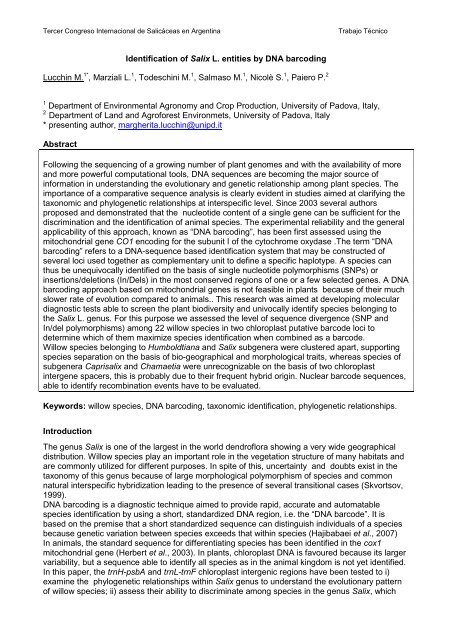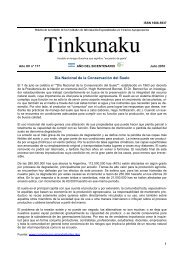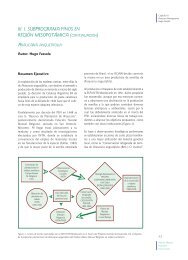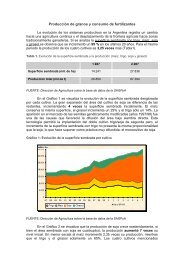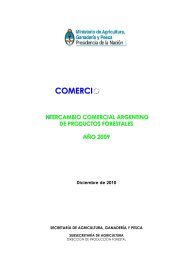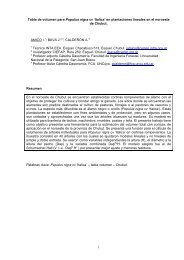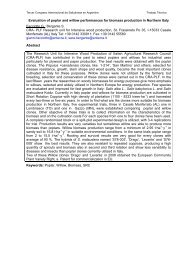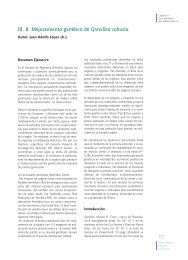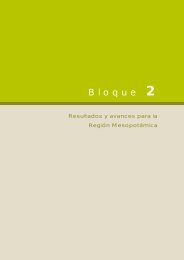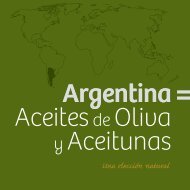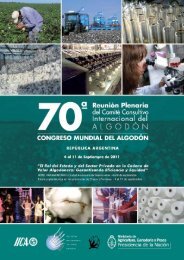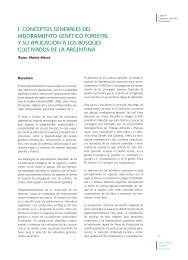Identification of Salix L. entities by DNA barcoding Lucchin M.1 ...
Identification of Salix L. entities by DNA barcoding Lucchin M.1 ...
Identification of Salix L. entities by DNA barcoding Lucchin M.1 ...
You also want an ePaper? Increase the reach of your titles
YUMPU automatically turns print PDFs into web optimized ePapers that Google loves.
Tercer Congreso Internacional de Salicáceas en Argentina Trabajo Técnico<br />
<strong>Identification</strong> <strong>of</strong> <strong>Salix</strong> L. <strong>entities</strong> <strong>by</strong> <strong>DNA</strong> <strong>barcoding</strong><br />
<strong>Lucchin</strong> M. 1* , Marziali L. 1 , Todeschini M. 1 , Salmaso M. 1 , Nicolè S. 1 , Paiero P. 2<br />
1 Department <strong>of</strong> Environmental Agronomy and Crop Production, University <strong>of</strong> Padova, Italy,<br />
2 Department <strong>of</strong> Land and Agr<strong>of</strong>orest Environmets, University <strong>of</strong> Padova, Italy<br />
* presenting author, margherita.lucchin@unipd.it<br />
Abstract<br />
Following the sequencing <strong>of</strong> a growing number <strong>of</strong> plant genomes and with the availability <strong>of</strong> more<br />
and more powerful computational tools, <strong>DNA</strong> sequences are becoming the major source <strong>of</strong><br />
information in understanding the evolutionary and genetic relationship among plant species. The<br />
importance <strong>of</strong> a comparative sequence analysis is clearly evident in studies aimed at clarifying the<br />
taxonomic and phylogenetic relationships at interspecific level. Since 2003 several authors<br />
proposed and demonstrated that the nucleotide content <strong>of</strong> a single gene can be sufficient for the<br />
discrimination and the identification <strong>of</strong> animal species. The experimental reliability and the general<br />
applicability <strong>of</strong> this approach, known as “<strong>DNA</strong> <strong>barcoding</strong>”, has been first assessed using the<br />
mitochondrial gene CO1 encoding for the subunit I <strong>of</strong> the cytochrome oxydase .The term “<strong>DNA</strong><br />
<strong>barcoding</strong>” refers to a <strong>DNA</strong>-sequence based identification system that may be constructed <strong>of</strong><br />
several loci used together as complementary unit to define a specific haplotype. A species can<br />
thus be unequivocally identified on the basis <strong>of</strong> single nucleotide polymorphisms (SNPs) or<br />
insertions/deletions (In/Dels) in the most conserved regions <strong>of</strong> one or a few selected genes. A <strong>DNA</strong><br />
<strong>barcoding</strong> approach based on mitochondrial genes is not feasible in plants because <strong>of</strong> their much<br />
slower rate <strong>of</strong> evolution compared to animals.. This research was aimed at developing molecular<br />
diagnostic tests able to screen the plant biodiversity and univocally identify species belonging to<br />
the <strong>Salix</strong> L. genus. For this purpose we assessed the level <strong>of</strong> sequence divergence (SNP and<br />
In/del polymorphisms) among 22 willow species in two chloroplast putative barcode loci to<br />
determine which <strong>of</strong> them maximize species identification when combined as a barcode.<br />
Willow species belonging to Humboldtiana and <strong>Salix</strong> subgenera were clustered apart, supporting<br />
species separation on the basis <strong>of</strong> bio-geographical and morphological traits, whereas species <strong>of</strong><br />
subgenera Caprisalix and Chamaetia were unrecognizable on the basis <strong>of</strong> two chloroplast<br />
intergene spacers, this is probably due to their frequent hybrid origin. Nuclear barcode sequences,<br />
able to identify recombination events have to be evaluated.<br />
Keywords: willow species, <strong>DNA</strong> <strong>barcoding</strong>, taxonomic identification, phylogenetic relationships.<br />
Introduction<br />
The genus <strong>Salix</strong> is one <strong>of</strong> the largest in the world dendr<strong>of</strong>lora showing a very wide geographical<br />
distribution. Willow species play an important role in the vegetation structure <strong>of</strong> many habitats and<br />
are commonly utilized for different purposes. In spite <strong>of</strong> this, uncertainty and doubts exist in the<br />
taxonomy <strong>of</strong> this genus because <strong>of</strong> large morphological polymorphism <strong>of</strong> species and common<br />
natural interspecific hybridization leading to the presence <strong>of</strong> several transitional cases (Skvortsov,<br />
1999).<br />
<strong>DNA</strong> <strong>barcoding</strong> is a diagnostic technique aimed to provide rapid, accurate and automatable<br />
species identification <strong>by</strong> using a short, standardized <strong>DNA</strong> region, i.e. the “<strong>DNA</strong> barcode”. It is<br />
based on the premise that a short standardized sequence can distinguish individuals <strong>of</strong> a species<br />
because genetic variation between species exceeds that within species (Hajibabaei et al., 2007)<br />
In animals, the standard sequence for differentiating species has been identified in the cox1<br />
mitochondrial gene (Herbert et al., 2003). In plants, chloroplast <strong>DNA</strong> is favoured because its larger<br />
variability, but a sequence able to identify all species as in the animal kingdom is not yet identified.<br />
In this paper, the trnH-psbA and trnL-trnF chloroplast intergenic regions have been tested to i)<br />
examine the phylogenetic relationships within <strong>Salix</strong> genus to understand the evolutionary pattern<br />
<strong>of</strong> willow species; ii) assess their ability to discriminate among species in the genus <strong>Salix</strong>, which
Tercer Congreso Internacional de Salicáceas en Argentina Trabajo Técnico<br />
can be considered as a model in the search for a barcode sequence because <strong>of</strong> its complexity and<br />
diffusion.<br />
Materials and Methods<br />
Following a multi-locus <strong>DNA</strong> <strong>barcoding</strong> approach, two non-coding chloroplast regions were tested<br />
across 22 willow species, each represented <strong>by</strong> two-five plants <strong>of</strong> different origin (Table 1). All<br />
plants are maintained in our willow collection at the Experimental Farm <strong>of</strong> the University <strong>of</strong> Padova,<br />
Italy. <strong>DNA</strong> was isolated from young leaves as in Meneghetti et al. (2007). The final concentration<br />
<strong>of</strong> <strong>DNA</strong> was estimated <strong>by</strong> electrophoresis on 1% agarose/TAE gel and quantification was made <strong>by</strong><br />
comparison with 1 Kb plus <strong>DNA</strong> ladder (Invitrogen) <strong>of</strong> known concentration. The trnH-psbA spacer<br />
was sequenced <strong>by</strong> using primer forward trnH CGCGCATGGTGGATTCACAATCC and reverse<br />
PsbA GTTATGCATGAACGTAATGCTC. To sequence trnL/trnF region the primers trnL<br />
GAGCACAGTGGTCAAGTTTA and trnF GGGGATAGAGGGACTTGAAC were utilized. PCR<br />
products were purified enzimatically <strong>by</strong> EXO-SAP (Amersham) procedure and then bi-directionally<br />
sequenced using ABI BigDye dye-terminators and cycle-sequencing protocols. Sequencing<br />
reactions were run on an ABI 3730xl <strong>DNA</strong> analyzer. Sequences were visualized <strong>by</strong> Sequencher<br />
3.0 (GeneCodes Corp).<br />
Before alignment, primer sequences were removed from both ends <strong>of</strong> sequences, so all<br />
sequences began and ended at homologous sites.<br />
Genetic divergence (d) among species sequences was calculated according to the Kimura-2parameter<br />
model (Kimura, 1980), as<br />
d = - ½ log e(w1) – ¼ log e(w2)<br />
Where w1= 1-2P-Q<br />
w2= 1-2Q<br />
with P and Q the frequency <strong>of</strong> transition and transversion respectively.<br />
Based on the multilocus pairwise nucleotide divergences, the Neighbor-joining analysis was<br />
performed <strong>by</strong> Mega 4.1 s<strong>of</strong>tware (Kumar et al., 2008) and a bootstrap statistical analysis was<br />
conducted to measure stability <strong>of</strong> the obtained branches using 1,000 resampling replicates.<br />
Populus nigra sample was added as outgroup. In addition, the different haplotypes were identified<br />
based on two loci.<br />
Results<br />
Genetic relationships among <strong>Salix</strong> species were investigated <strong>by</strong> a multilocus <strong>DNA</strong> <strong>barcoding</strong><br />
approach based on the sequence divergences <strong>of</strong> two chloroplast intergenic regions, trnH-psbA<br />
and the trnL/trnF.<br />
The total lengths <strong>of</strong> the trnH-PsbA and the trnL/trnF regions were confirmed using a comparative<br />
alignment with sequences obtained from GenBank. The final aligned matrix had a total length <strong>of</strong><br />
635 characters, 284 and 351 sites for trnH-PsbA and trnL/trnF respectively. The phylogenetic<br />
analysis resulted in a well-resolved and well supported tree (Figure 1) and seven willow haplotypes<br />
were identified:<br />
- Haplotype 1: S. alba, S. fragilis and S. pentandra;<br />
- Haplotype 2: S. acmophylla;<br />
- Haplotype 3: S. humboldtiana;<br />
- Haplotype 4: S. brutia;<br />
- Haplotype 5: S. triandra;<br />
- Haplotype 6: S. eleagnos, S. breviserrata, S. retusa, S. purpurea, S. apenina, S.<br />
mielich<strong>of</strong>eri, S. foetida, S. waldsteniana, S. rosmarinifolia, S. caprea, S. appendiculata,<br />
S. canariensis, S. daphnoides and S. myrsinifolia;<br />
- Haplotype 7: S. atrocinerea.<br />
Two main groups can be recognized in the phylogenetic tree: species belonging to subgenus <strong>Salix</strong><br />
clustered apart from the main group showing species <strong>of</strong> subgenera Vetrix and Chametia, so<br />
supporting species separation on the basis <strong>of</strong> bio-geographical and morphological traits. Within<br />
subgenus <strong>Salix</strong>, that botanists consider the least evolved and the most related to the genus<br />
Populus (Martini & Paiero, 1988), species <strong>of</strong> sections Amygdalinae and Humboldtianae resulted to
Tercer Congreso Internacional de Salicáceas en Argentina Trabajo Técnico<br />
be well separated according to their different distribution. S. alba, S. fragilis and S. pentandra did<br />
not show any nucleotide polymorphism in the two loci analysed, thus confirming their strong<br />
relationships: according to Skvortsov (1999), the two sections <strong>Salix</strong> and Pentandrae <strong>of</strong> the<br />
subgenus <strong>Salix</strong> have close relationships, and S. pentandra to some extents resembles S. fragilis.<br />
In section <strong>Salix</strong>, white willow and crack willow are known to constitute the S. alba-S. fragilis<br />
complex together with their hybrids and introgressants (Barcaccia et al., 2003).<br />
Our preliminary results confirm the potentials <strong>of</strong> <strong>DNA</strong> <strong>barcoding</strong> technique as a powerful tool to be<br />
exploited for the genetic identification <strong>of</strong> willow species allowing to overpass the taxonomic<br />
impediments due to life and phenological stages or dioecism. However, the two chloroplast loci<br />
here considered were not able to distinguish all willow species showing some criticisms and<br />
suggesting further loci will have to be investigated. The conventional <strong>barcoding</strong> approach is based<br />
on reproductive isolation causing the accumulation <strong>of</strong> molecular differences. Due to the common<br />
interspecific hybridization which led the evolution <strong>of</strong> <strong>Salix</strong> species, nuclear regions will have to be<br />
assessed.<br />
References<br />
Barcaccia G, Meneghetti S, Albertini E, Triest L, <strong>Lucchin</strong> M., 2003. Linkage mapping in tetraploid<br />
willows: segregation <strong>of</strong> molecular markers and estimation <strong>of</strong> linkage phases support an<br />
allotetraploid structure for <strong>Salix</strong> alba x <strong>Salix</strong> fragilis interspecific hybrids. Heredity, 90, 169-180.<br />
Brullo S, Spampinato G, 1993. A new species <strong>of</strong> <strong>Salix</strong> (Salicaceae) from Calabria (S Italy).<br />
Candollea 48 (1), 291-295.<br />
Hajibabaei M, Singer GAC, Herbert PDN, Hickey DA, 2007. <strong>DNA</strong> <strong>barcoding</strong>: how it complements<br />
taxonomy, molecular phylogenetics and population genetics. Trends Genet., 23, 167-172.<br />
Herbert PDN, Cywinska A, Ball SL, de Waard JR, 2003. Biological identification trough <strong>DNA</strong><br />
barcodes. Proc. R. Soc. Lond B, 270, 313-321.<br />
Kimura M, 1980. A simple method for estimating evolutionary rates <strong>of</strong> base substitutions through<br />
comparative studies <strong>of</strong> nucleotide sequences. J. <strong>of</strong> Mol. Evol., 16 (2), 111-120.<br />
Kumar S, Dudley J, Nei M, Tamura K, 2008. MEGA: a biologist-centric s<strong>of</strong>tware for evolutionary<br />
analysis <strong>of</strong> <strong>DNA</strong> and protein sequences. Brief. in Bioinformatics 9: 299-306.<br />
Martini F, Paiero P, 1988. I salici d’Italia. Ed. Lint, Trieste, Italy.<br />
Meneghetti S, Barcaccia G, Paiero P, <strong>Lucchin</strong> M, 2007. Genetic characterization <strong>of</strong> <strong>Salix</strong> alba L.<br />
and <strong>Salix</strong> fragilis L. <strong>by</strong> means <strong>of</strong> different PCR-derived marker systems. Pl. Biosystems, 141 (3),<br />
283-291.<br />
Skvortsov AK, 1999. Willows <strong>of</strong> Russia and adjacent countries. Taxonomical and geographical<br />
revision. University <strong>of</strong> Joensuu Publ. Joensuu, Finland.<br />
Table 1: List <strong>of</strong> the 22 analysed willow species. Taxonomy is according to Skvortsov (1999).<br />
(a) Classification <strong>of</strong> S. brutia is according to Brullo and Spampinato (1993).<br />
Species No. <strong>of</strong> plants Subgenus Section<br />
S. acmophylla 2 <strong>Salix</strong> Humboldtianae<br />
S. alba 5 <strong>Salix</strong> <strong>Salix</strong><br />
S. apennina 2 Vetrix Nigricantes<br />
S. appendiculata 3 Vetrix Vetrix<br />
S. atrocinerea 3 Vetrix Vetrix<br />
S. breviserrata 2 Chamaetia Myrtosalix<br />
S. brutia (a) 3 <strong>Salix</strong> Amygdalinae<br />
S. canariensis 3 Vetrix Vetrix<br />
S. caprea 3 Vetrix Vetrix
Tercer Congreso Internacional de Salicáceas en Argentina Trabajo Técnico<br />
S. daphnoides 2 Vetrix Daphnella<br />
S. eleagnos 2 Vetrix Canae<br />
S. foetida 2 Vetrix Arbuscella<br />
<strong>Salix</strong> fragilis 4 <strong>Salix</strong> <strong>Salix</strong><br />
<strong>Salix</strong> humboldtiana 3 <strong>Salix</strong> Humboldtianae<br />
<strong>Salix</strong> mielich<strong>of</strong>eri 4 Vetrix Nigricantes<br />
<strong>Salix</strong> myrsinifolia 4 Vetrix Nigricantes<br />
<strong>Salix</strong> pentandra 2 <strong>Salix</strong> Pentandrae<br />
<strong>Salix</strong> purpurea 4 Caprisalix Helix<br />
<strong>Salix</strong> retusa 2 Chamaetia Retusae<br />
<strong>Salix</strong> rosmarinifolia 4 Vetrix Incubaceae<br />
<strong>Salix</strong> triandra 3 <strong>Salix</strong> Amygdalinae<br />
S. waldsteniana 2 Vetrix Arbuscella
Tercer Congreso Internacional de Salicáceas en Argentina Trabajo Técnico<br />
Figure 1: Phylogenetic tree obtained <strong>by</strong> analysing trnH-PsbA and trnL/trnF combined loci. The<br />
numbers above the nodes represent bootstrap support after 1,000 replicates.


